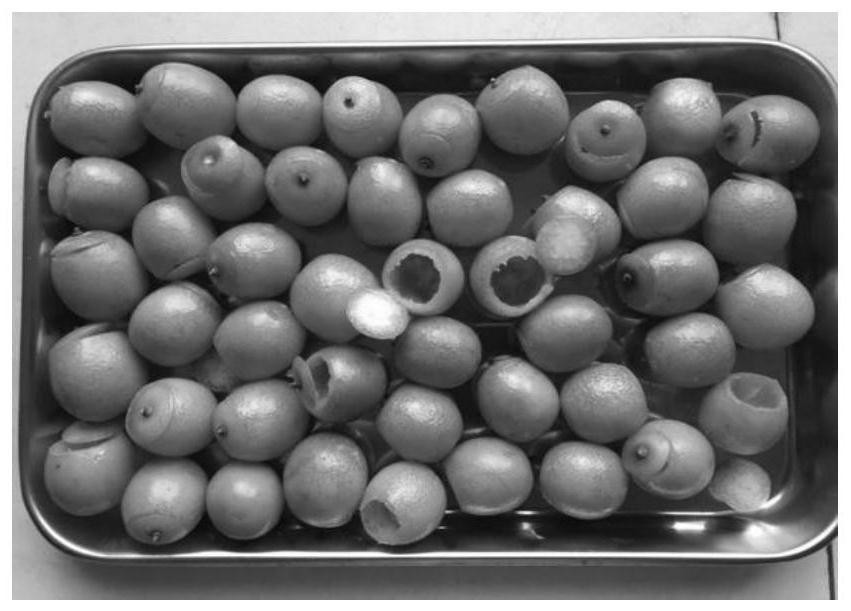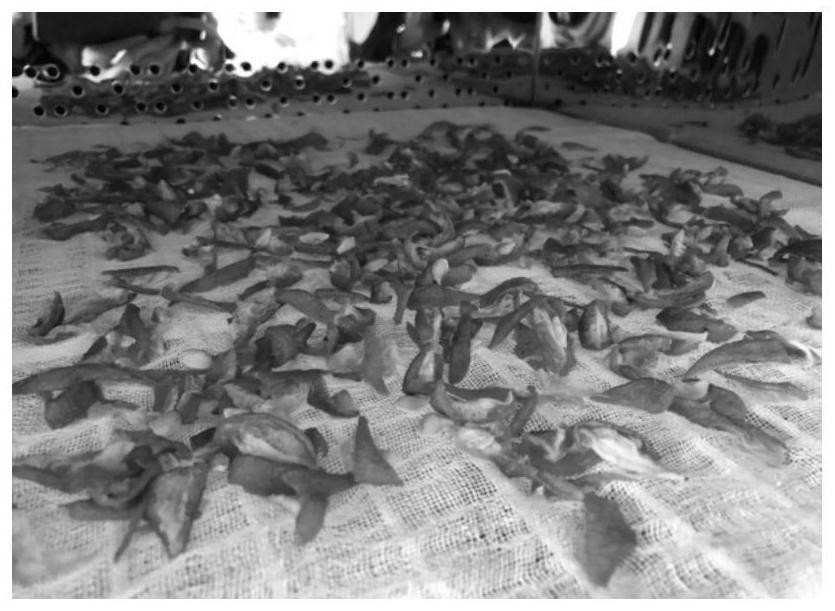Processing method of kumquat tea
A processing method, kumquat technology, applied in tea treatment before extraction, etc., can solve problems such as short shelf life, waste of tea resources, and difficult storage of kumquat, so as to achieve the effect of sweet taste of tea, increase utilization rate, and reduce bitterness and astringency
- Summary
- Abstract
- Description
- Claims
- Application Information
AI Technical Summary
Problems solved by technology
Method used
Image
Examples
Embodiment 1
[0027] (1) Select 7 mature kumquats with uniform shape, beautiful appearance and no damage.
[0028] (2) Clean the selected kumquats and dry them for later use.
[0029] (3) Make a cut at a quarter of the top of the kumquat, but do not cut it to maintain the shape of the top cover;
[0030] (4) Use a spoon to hollow out the kumquat flesh and keep the kumquat peel shell;
[0031] (5) take the fresh leaves of summer and autumn tea as black tea raw material, after cooling and withering until the moisture content is 35%, at a temperature of 35 ° C, carry out a constant temperature kneading for 50min, at a temperature of 35 ° C and under a sealed environment, add licorice The juice is fermented at a constant temperature for 2 hours, the weight ratio of black tea raw materials and licorice juice is 1:2, then at a temperature of 80 ° C, roasted to a moisture content of 20%, cooled to 30 ° C, and then at a temperature of 35 ° C, for a second constant temperature kneading 25min, and ...
Embodiment 2
[0036] (1) Select 8 mature kumquats with uniform shape, beautiful appearance and no damage.
[0037] (2) Clean the selected kumquats and dry them for later use.
[0038] (3) Incision at one-fifth of the top of the kumquat, but not cut off, to maintain the shape of the top cover;
[0039] (4) Use a spoon to hollow out the kumquat flesh and keep the kumquat peel shell;
[0040] (5) take the fresh leaves of summer and autumn tea as black tea raw material, after cooling and withering until the moisture content is 50%, at a temperature of 32 ° C, carry out a constant temperature kneading for 50min, at a temperature of 32 ° C and under a sealed environment, add licorice The juice is fermented at a constant temperature for 3.5 hours, the weight ratio of black tea raw materials and licorice juice is 1:4, then at a temperature of 90 ° C, baking to a moisture content of 30%, cooling to 30 ° C, and then at a temperature of 32 ° C, a secondary constant temperature is carried out Kneadin...
Embodiment 3
[0045] (1) Select 8 mature kumquats with uniform shape, beautiful appearance and no damage.
[0046] (2) Clean the selected kumquats and dry them for later use.
[0047] (3) Incision at one-fifth of the top of the kumquat, but not cut off, to maintain the shape of the top cover;
[0048] (4) Use a spoon to hollow out the kumquat flesh and keep the kumquat peel shell;
[0049] (5) take the fresh leaves of summer and autumn tea as the black tea raw material, after cooling and withering until the moisture content is 40%, at a temperature of 40 ° C, carry out a constant temperature kneading for 50min, at a temperature of 40 ° C and under a sealed environment, add licorice The juice is fermented at a constant temperature for 3.5 hours, the weight ratio of black tea raw material and licorice juice is 1:3, then at a temperature of 90 ° C, roasted to a moisture content of 25%, cooled to 30 ° C, and then at a temperature of 40 ° C, a secondary constant temperature is carried out Knea...
PUM
 Login to View More
Login to View More Abstract
Description
Claims
Application Information
 Login to View More
Login to View More - R&D
- Intellectual Property
- Life Sciences
- Materials
- Tech Scout
- Unparalleled Data Quality
- Higher Quality Content
- 60% Fewer Hallucinations
Browse by: Latest US Patents, China's latest patents, Technical Efficacy Thesaurus, Application Domain, Technology Topic, Popular Technical Reports.
© 2025 PatSnap. All rights reserved.Legal|Privacy policy|Modern Slavery Act Transparency Statement|Sitemap|About US| Contact US: help@patsnap.com



